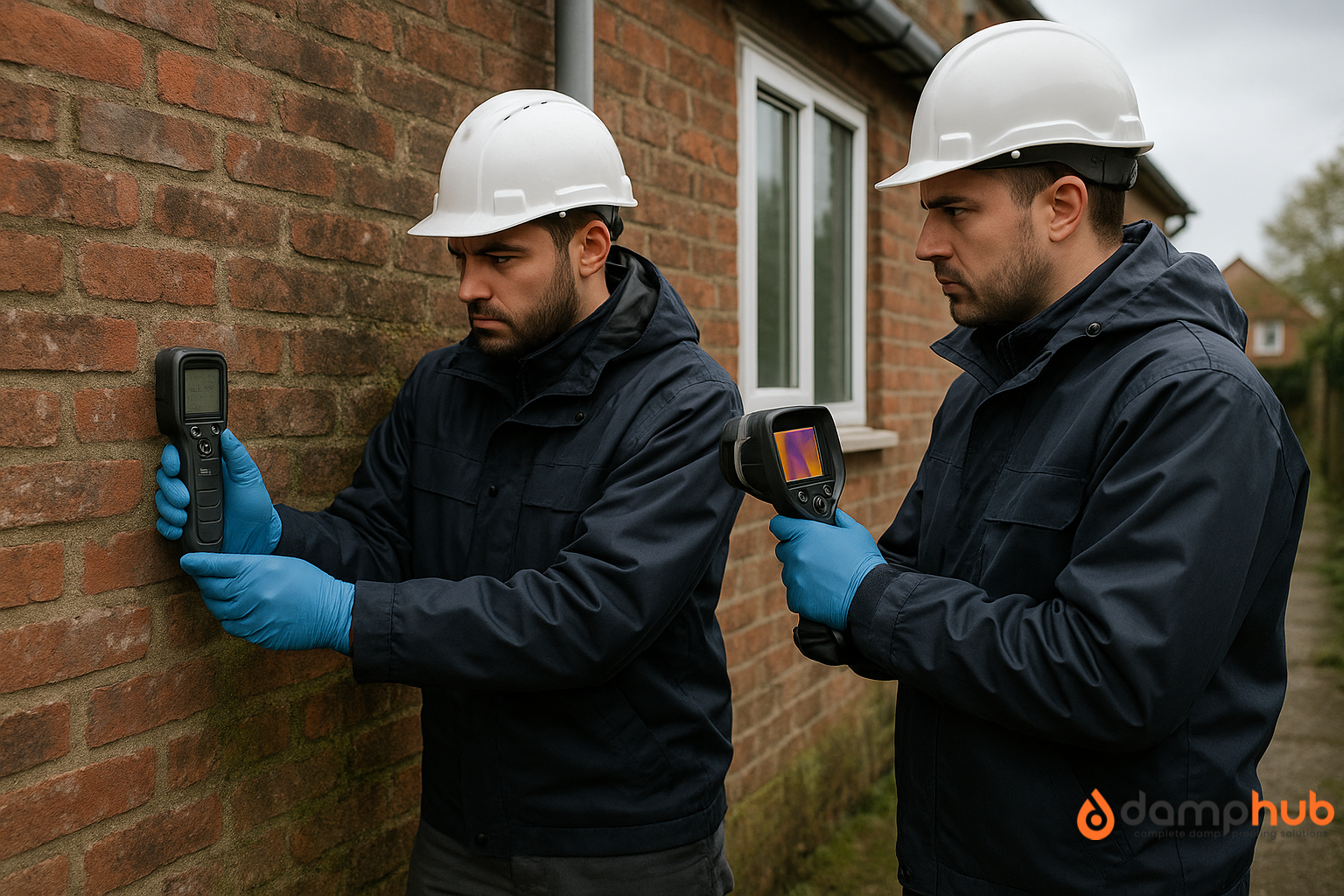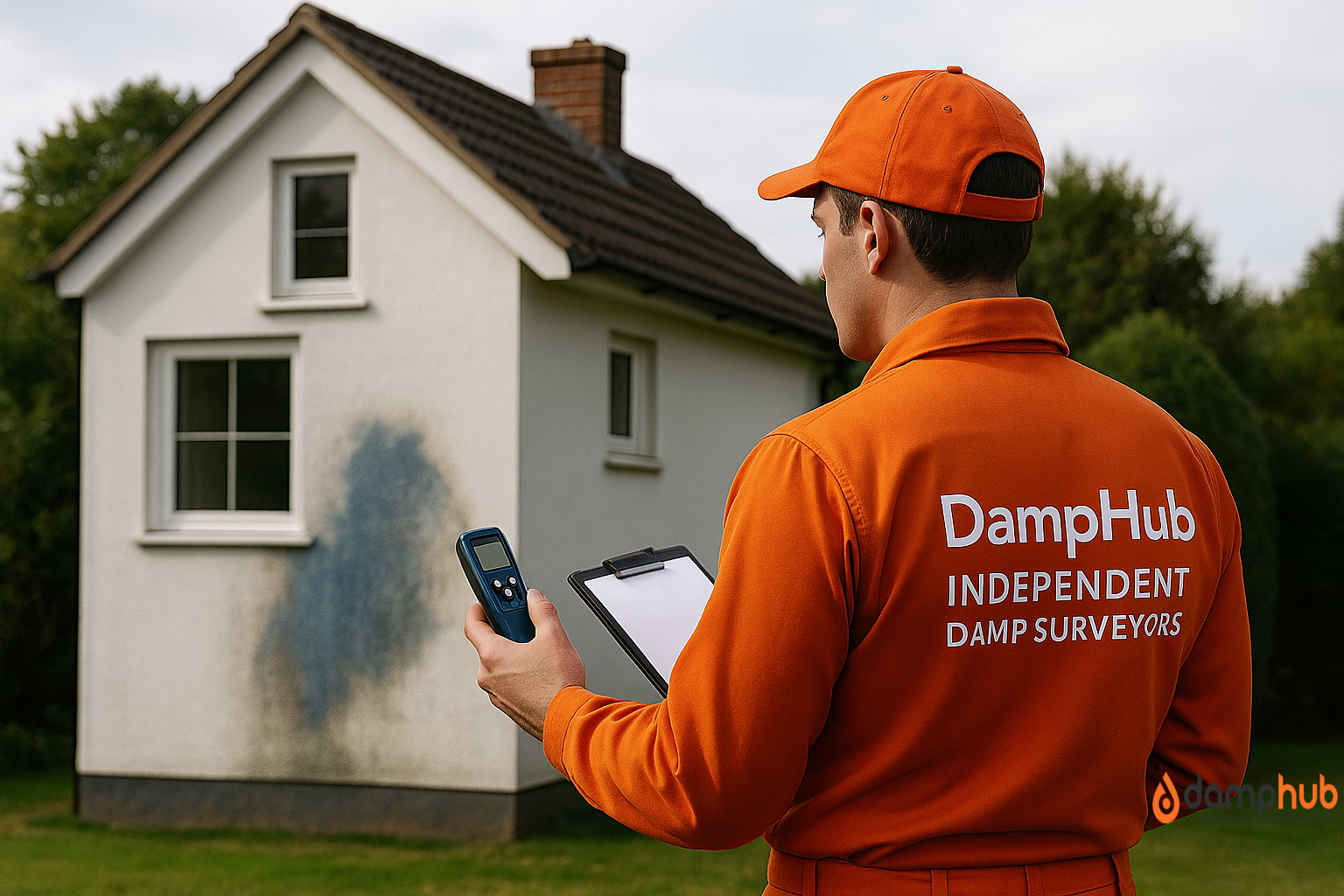
Quick Takeaways
- ✓ A damp and timber report checks for rising damp, wood rot, and insect damage.
- ✓ Buyers usually pay for the report, especially if it’s tied to a mortgage or legal check.
- ✓ Sellers may choose to cover the cost to reassure buyers and speed up the sale.
- ✓ Costs range from £150 to £400, depending on property size and urgency.
- ✓ Reports from PCA-accredited surveyors are often required by lenders.
When buying or selling a property, a range of reports and inspections may come into play to ensure the condition of the building is sound.
One of the most common—and sometimes misunderstood—is the timber and damp report.
But who should foot the bill for this inspection: the buyer or the seller?
Let’s break it down to help you understand what the report involves, when it’s needed, and most importantly, who typically pays.
What is a Damp and Timber Report?
A damp and timber report is a specialist survey that investigates two key problem areas in a property:
- Damp issues such as rising damp, penetrating damp, and condensation.
- Timber decay, including woodworm, wet rot, and dry rot.
These problems can compromise the structural integrity of a property and lead to expensive repairs if not identified early.
The report is usually carried out by a certified damp and timber surveyor, ideally a member of the Property Care Association (PCA) or an equivalent professional body in the UK.
When is a Damp and Timber Report Needed?
This report is often recommended or requested in several situations:
- During a property sale or purchase, especially if a general home survey reveals moisture or timber issues.
- By mortgage lenders who need assurance that the property is free from major defects before approving a loan.
- By homeowners considering renovations or noticing signs such as damp patches, musty odours, or timber damage.
- As part of a pre-purchase check, especially for older buildings or properties with a history of damp problems.

Who is Usually Responsible for Paying?
There is no legal requirement stating who must pay for a damp and timber report, so it typically depends on who requests it and the stage of the property transaction.
Here are the common scenarios:
1. Buyer Pays
Most commonly, the buyer covers the cost of the report if:
- It’s requested as part of their due diligence before committing to the purchase.
- A general homebuyer’s or building survey suggests damp or timber concerns.
- They want independent verification to negotiate the price or budget for repairs.
2. Seller Pays
Sellers might decide to pay for the report if:
- They’re aware of damp or timber issues and want to show these have been professionally assessed or addressed.
- They want to make the property more attractive to buyers by being transparent.
- They wish to speed up the sale and reduce potential objections or price negotiations.
3. Shared Responsibility
In some cases, the buyer and seller may agree to split the cost, for example, when both parties are motivated to close the deal quickly, or when it’s unclear who benefits most from the report.
However, this is less common and usually requires negotiation.
What Do Mortgage Lenders or Conveyancers Expect?
If a mortgage lender or a conveyancing solicitor raises concerns about potential damp or timber issues, they may recommend or require a report.
In these situations:
- The buyer typically arranges and pays for the report to satisfy lender or legal requirements.
- Some mortgage providers will only accept reports from PCA-accredited surveyors or companies.
If the report reveals significant problems, the lender may withhold the mortgage offer or reduce the loan amount until repairs are made.
Cost of a Damp and Timber Report
The price of a damp and timber report in the UK typically ranges from £150 to £400, depending on:
- The size and location of the property.
- Whether the inspection is standalone or part of a larger survey.
- How quickly the report is needed (urgent surveys may cost more).
If the report reveals issues, further investigation or remedial work may be needed, adding to the overall cost.

Tips for Deciding Who Should Pay
If you’re not sure who should pay for the report, consider the following:
- Open communication: Talk to the other party and clarify expectations early on.
- Negotiation leverage: A buyer might request the seller to cover the cost or reduce the asking price based on the report findings.
- Transparency benefits: Sellers who proactively commission a report may speed up the sale and build trust.
Most importantly, ensure the agreement is documented in writing, especially when part of a sales negotiation.
Conclusion
So, who should pay for a damp and timber report?
While the buyer most often covers the cost, especially when it’s a lender requirement or part of their own due diligence, the seller may choose to pay in certain circumstances to provide reassurance or gain a competitive edge.
There’s no fixed rule, but clear communication and upfront agreements can save both parties time, money, and stress during the property transaction process.
Need a Damp and Timber Survey?
Looking for a reliable, PCA-registered surveyor?
Contact our expert team for fast, detailed reports that help you buy or sell with confidence.
Quick Recaps
- ✓ Get a report if you’re buying, selling, renovating, or spotting signs like damp patches or musty smells.
- ✓ Always check if your mortgage lender or solicitor expects one before proceeding.
- ✓ The report highlights problems early, before they turn into major structural costs.
- ✓ No fixed rule on who pays — it depends on who requests it and what’s agreed during the deal.
- ✓ Whatever’s decided, get it in writing to avoid confusion later.
FAQs
What is involved in a damp and timber survey?
A damp and timber survey checks for moisture problems in walls and damage in wood, like rot or insect attack.
A surveyor uses tools such as moisture meters and probes to inspect the property, especially areas like skirting boards, floors, and ceilings.
They look for signs of rising damp, wet rot, dry rot, and woodworm. After the inspection, the surveyor writes a report. This explains what was found, what’s causing the problem, and what repairs or treatments are needed.
How do you investigate damp?
To investigate damp, you look for signs like mould, stains, or peeling paint. A moisture meter is used to test how wet the walls or floors are.
Then you check the area to find the cause, like a leak, blocked gutter, poor ventilation, or rising damp.
A surveyor can give a full report showing the type of damp and the right treatment.
How do you test for moisture in wood?
A moisture meter is used to check how much water is in the wood. You press it against the timber, and it gives a reading.
If it’s above 20%, the wood is too wet and could rot. Several areas should be tested for a full picture.
Surveyors often include the moisture readings in their report.
How do you identify wet rot in timber?
Wet rot makes timber soft, darker, and sometimes crumbly. Paint might peel, and the wood could feel spongy when pressed.
It often shows up in damp areas with leaks or poor airflow.
A surveyor will inspect the timber and confirm if it’s wet rot, then recommend how to treat or replace the damaged sections.
How to test for dry rot in wood?
Dry rot makes the wood crack and break easily. You might see white, fluffy growth or orange dust (spores). A musty smell is common.
Dry rot can spread fast, even through brick or plaster. A proper inspection will test the wood and the surrounding area.
The report will explain how far it’s spread and what to do next.
How do you treat damp wood?
First, fix what’s causing the damp, like leaks or poor ventilation. Then dry out the area using heaters or dehumidifiers.
Remove mould or surface damage with a wire brush. If the wood is badly damaged, it needs to be cut out and replaced.
If it’s still strong, a wood treatment can be applied. A professional may include these steps in a written plan or repair report.






